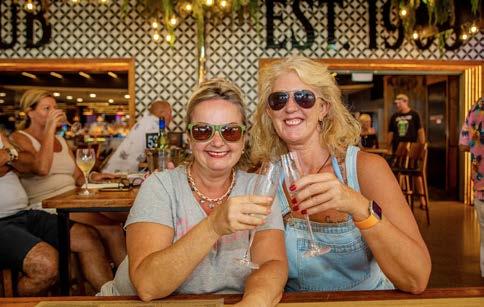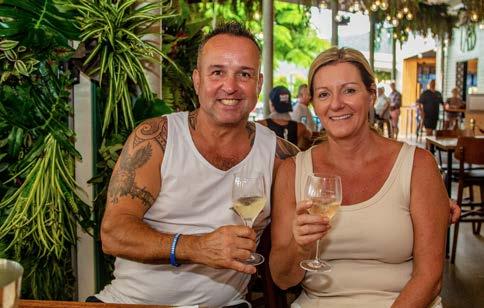
3 minute read
Social Life Orchid Society Celebrate 60 Years
Over 40 avid orchid enthusiasts attended a celebratory afternoon to mark 60 years of the Proserpine Orchid and Foliage Society on Saturday.
The event saw visitors attend from across the region, including representatives from the Bowen Orchid and Foliage Society, Bowen Garden Club and Whitsunday Garden
Advertisement
President of the Tropical Queensland Orchid Council (TQOC), Dennis Farlow, attended with his wife Ros.
Dennis is also President of the Mackay and District Orchid Society.
Everyone was also very pleased to see Whitsunday Regional Council
Mayor Julie Hall attend and during her speech she presented the Proserpine Orchid Society with a framed notice of appreciation from Council on its sixtieth anniversary.

“A sixty-year anniversary for a community group is an amazing achievement,” Mayor Julie Hall said.
“That’s older than me! To get to that age is simply amazing and to see so many people here today is absolutely wonderful. It’s societies and communities like this that make our community as a whole.
“On behalf of Whitsunday Regional Council: congratulations.”
After Mayor Julie’s speech the celebratory cake was cut, and a slideshow depicted the 60 year history of the Orchid Society was presented.
The Proserpine and Orchid Society meet on the fourth Saturday of the month at 1.30pm at the Queensland Country Women’s Association (QCWA) Hall in Proserpine.
Each year the club hold a Fields Day where orchid societies from across the region are invited to join the group, explore local gardens and enjoy a sausage sizzle.
The next one will take place on July 23 this year at the Proserpine Tennis Club venue.
The Orchid Society also hold an annual Christmas party on the second Saturday in December, in a combined event with the Bowen Garden Club, the Whitsunday Garden Club and the Bowen Orchid and Foliage Society members.

All new members are welcome, and the Society looks forward to celebrating another 60 years.

Organisers would like to thank everyone who helped organise their 60th celebrations and those who brought a plate of food on the day.
One hundred years ago, the tourism potential of the Whitsundays was “not even a twinkle in the first developer’s eye.” Those beautiful islands were just 74 secrets kept by several families who had taken out residential or grazing leases. The idea of spending a holiday on Hamilton or Hayman was yet to crystallise. Only one family lived near Cannon Valley Beach as it was then known. By the 1920s, the dirt road from Proserpine still took two very bumpy hours to navigate, although the beach was becoming a popular picnic destination.
However, after World War One, scientific interest began to be attracted north and, in 1922, The Great Barrier Reef Committee was founded as part of the Royal Geographical Society of Australasia. One of its early expeditions called in on Lindeman Island for a day. Four years later, another visited the islands near Mackay. Enjoying this trip was a young New South Wales schoolteacher called Edwin Montague Embury. Embury was inspired to organise his own expeditions to the Whitsundays on a much larger scale and these excursions formed the foundation of tourism in this area.
“A qualified teacher, Monty’s delight in life was to pass a learning experience on to others – perhaps it was the qualified teacher in him! He undertook in his own time the organisation of expeditions to coral reef areas for the enlightenment and enjoyment of others. He was a meticulous organiser with the drive, energy and ability to draw around himself an enthusiastic band of technical advisers and helpers.”
(Ray
Blackwood)
The first trip at Christmas 1928 was planned to sail from Bowen to headquarters on Lindeman but met with problems which could have proved disastrous to lesser men. With his brother, Arch, he met in advance the skippers of the five boats he had planned to use, including Boyd Lee, Bruce Jamieson and the Hallam brothers but the Bowen Harbour Master noted that none were licensed or fitted out as passenger ships. Monty was threatened with imprisonment if he went ahead as planned and yet, somehow, he had to transport 116 guests to Lindeman in a couple of days.
Realising that there was no harbour master at Cannon Valley, he contacted a pub in Proserpine, moved extra stretchers and mattresses to every corner of it and telegrammed the main party from NSW to get off the train early at Proserpine. As there were no buses, he hired trucks to take the party to Cannon Valley Beach where dinghies would take people to waiting boats. Consequently, luggage had to be carried through knee deep mud. Tents supplemented the facilities built by the Nicolsons at Lindeman and days were spent on boat trips to the reef and islands with expert commentary, swimming and fishing, while in the evenings a mixture of lectures, concerts, dances and fancy-dress events were organised. Leading scientists such as Mel Ward of the Australian Museum and Frank McNeill were persuaded to share their passions and, in return, were allowed to take back rare specimens of fish, coral, insects, seaweed, birds and the like to the Australian Museum. A new species of game fish was discovered and was fittingly named Turrum Emburyi.
Hundreds of photographs were taken. Arch Embury even developed a primitive and dangerous technique for filming underwater. Using a camera mounted behind glass, Arch would lean over the side of the boat with his head underwater to take the shot while Monty held his body weight with a strap.

To be continued…



















